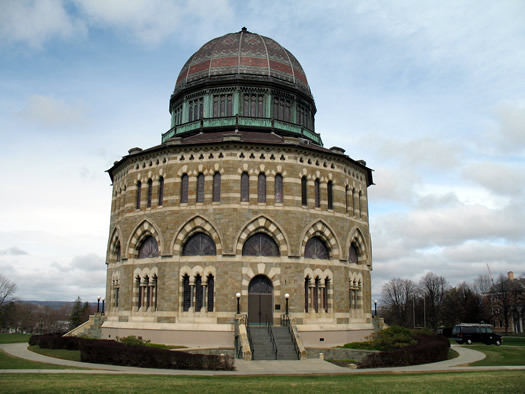US News ranks for Capital Region colleges

Union will probably Nott be disappointed.
US News released its vaunted college rankings today (not important, of course... unless your school ranked well). Here's how local schools ranked.
(Plus a ranking in which UAlbany tops RPI.)
National Universities
#50 Rensselaer Polytechnic Institute
Described as "most selective" (40% acceptance rate), with a "high" 4-year graduation rate (65%). Also "high" room and board fees ($11,975). By the way: RPI is 71.5-28.5 male to female. And 54% of students are engineering majors. (RPI was ranked #41 last year)
#138 University at Albany
Described as "selective" (47% acceptance rate), with a "medium" 4-year graduation rate (55%). And "high" room and board fees ($10,958) -- though in-state tuition is $7,172. (UAlbany was ranked #143 last year.)
Princeton and Harvard tied for #1 in this category.
National Liberal Arts Colleges
#40 Union College
Described as "more selective" (42% acceptance rate), with a "high" 4-year graduation rate (74%). (Union was ranked #41 last year.)
#49 Skidmore College
Described as "more selective" (47% acceptance rate), with a "high" 4-year graduation rate (80%). And "high" room and board fees ($11,304). By the way: Skidmore is 62-38 female to male.
#112 Siena college
Described as "selective" (60% acceptance rate), with a "high" 4-year graduation rate (74%). And "high" room and board fees ($11,434). By the way: 70 percent of Siena students have a car on campus.
The #1 school on this list is Williams College, just across the border in Williamstown.
Regional Universities (North)
#39 College of St. Rose
Described as "selective" (64% acceptance rate), with a "high" 4-year graduation rate (57%). And "high" room and board fees ($10,422). Gender split: 69-31 female to male.
#49 Sage Colleges
Described as "selective" (68% acceptance rate), with a "medium" 4-year graduation rate (46%). And "high" room and board fees ($10,675). Gender split: 79-21 female to male.
A different sort of ranking
The Washington Monthly recently released its own set of college rankings, with a focus on "on [schools'] contribution to the public good in three broad categories: Social Mobility (recruiting and graduating low-income students), Research (producing cutting-edge scholarship and PhDs), and Service (encouraging students to give something back to their country)."
National Universities
#76 University at Albany (with relatively high marks for social mobility and community service)
#77 Rensselaer Polytechnic Institute (with relatively low marks for social mobility and community service, and high marks for research)
Liberal Arts Colleges
#90 Skidmore College (relatively high marks for social mobility)
#103 Union College (a high mark for research expenditures)
#179 Siena College (relatively lower marks for community service)
Earlier on AOA:
+ Where Capital Region colleges rank on Princeton Review lists
+ Union, RPI in top 20 for "return on investment"
+ Skidmore, Union, RPI among nation's most expensive
Hi there. Comments have been closed for this item. Still have something to say? Contact us.
Comments
I think we need to view college rankings with more than a grain of salt. But they can be of some help if you know how to use them. For a reasonably balanced perspective on the pros and cons of U.S. News & World Report’s college rankings, see this NYT’s blog article:
http://thechoice.blogs.nytimes.com/2011/09/13/us-news/
... said Bob on Sep 13, 2011 at 6:47 PM | link
CLAREMONT MCKENNA HOLLAAAAA
... said ike on Sep 13, 2011 at 9:45 PM | link
SUNYA topped RPI in the Forbes Ranking as well.
... said ned on Sep 14, 2011 at 10:19 AM | link
These rankings are part of the "gimmick" economy: lets rate and rank everything known to man, provide a justification for the evaluations, account for several hundred institutions in a variety of fields so as to look "comprehensive," serve with a healthy dose of advertisements. Consuming public, enjoy.
... said Cincinnatus on Sep 14, 2011 at 8:27 PM | link
I would even go a step further: publications such as these are not even for the college-bound, the collegian-to-be, so much as they are for his/her parents, who hover anxiously in the foreground, guiding their child's first tentative steps into the brave new world of only nominal adulthood.
These are yet another form of the "blue" pill for the American weary.
... said Cincinnatus on Sep 15, 2011 at 12:24 AM | link